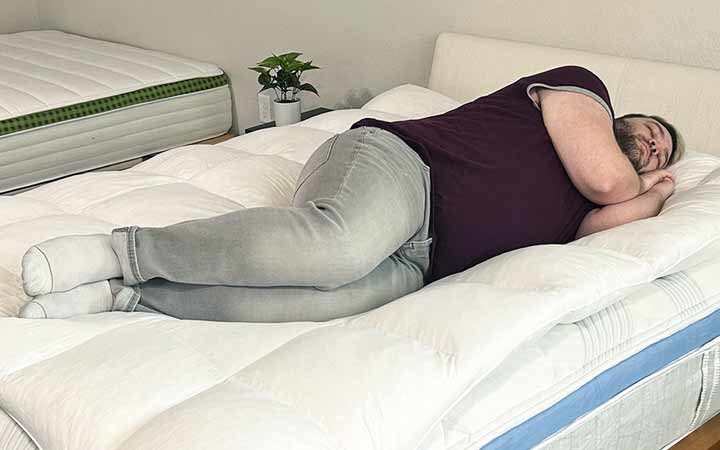
Pressure relief is an essential factor when choosing a mattress, because it directly affects the quality of your sleep and overall well-being. Many people experience joint pain, back pain, and other discomforts that can be soothed by the right amount of pressure relief.
We emphasize pressure relief in our mattress testing process and comprehensive reviews. Why is it so important, and how do we test for it? Read on to find out.
Why is Pressure Relief Important in a Mattress?
Pressure relief refers to a mattress’s ability to distribute your weight evenly and reduce the pressure on specific points of the body, such as the shoulders, hips, and lower back. A mattress with good pressure relief helps to alleviate stress on these pressure points, promoting proper spinal alignment (especially for side sleepers) and reducing the risk of discomfort or pain.
How We Test Mattresses for Pressure Relief
Gauging pressure relief is both an art and a science. So, how do we go about it?
First, we have multiple experts test each mattress. They have different preferred sleeping positions and body types, which helps give a more well-rounded experience of a mattress’s pressure-relieving ability. They’ll compare their notes on how cushioned they felt and how much the bed cradled their joints.


They also lie on an electronic mat that generates what we call a “pressure map.” This is a color-coded visual of the tester’s silhouette in different sleeping positions. We can see what areas of the body are most at risk for pressure buildup because the increased pressure shows up in lighter colors: yellow, orange, and red. A pressure map that’s entirely blue and green indicates a bed with stellar pressure relief.
Below, you can see three separate side-sleeping pressure maps from three different mattresses. Note how the pressurized areas change in location and severity.



The mat also tells us the PSI (pounds per square inch) being exerted by the tester. This is a numerical measure of pressure that also clues us into the overall pressure-relieving capabilities of the bed. For a back sleeper, a PSI of 12 or less is pretty great. For a side sleeper, we want to see a PSI around 14 or less.
The Best Firmness Level For Pressure Relief
Mattress firmness is rated from 1-10, with 1 being the softest and 10 being the firmest. The ideal firmness level for pressure relief varies depending on your sleeping position and body type. Generally, though, you’ll want a mix of pleasant softness and adequate support that prevents too much sinkage.
Check out the charts below for a detailed breakdown of ideal firmness based on body type and sleep position.
Side Sleepers
| Body Weight | Suggested Firmness |
| Lightweight (under 130 lb) | 5 to 6.5/10 |
| Average (130 – 230 lb) | 6 to 6.5/10 |
| Heavyweight (over 230 lb) | 6.5 to 7/10 |
Back Sleepers
| Body Weight | Suggested Firmness |
| Lightweight (under 130 lb) | 6.5/10 |
| Average (130 – 230 lb) | 6.5 to 7/10 |
| Heavyweight (over 230 lb) | 7 to 7.5/10 |
Stomach Sleepers
| Body Weight | Suggested Firmness |
| Lightweight (under 130 lb) | 6.5 to 7/10 |
| Average (130 – 230 lb) | 7 to 7.5/10 |
| Heavyweight (over 230 lb) | 7.5 to 8/10 |
Combination Sleepers
If you’re a combination sleeper, you’ll need to find a happy medium based on which positions you find yourself in during the night and your body type, based on the charts above.
What’s the Best Type of Mattress for Pressure Relief?
Another critical piece of pressure relief is the material your mattress is made of. Different materials offer varying levels of support and contouring capabilities. We explore some of the best options for pressure relief below.
Memory Foam

Memory foam mattresses are renowned for their exceptional pressure-relieving properties. The unique ability of memory foam to contour to the body’s shape helps distribute weight evenly, reducing pressure on sensitive areas such as the hips, shoulders, and lower back. This material is especially beneficial for individuals with chronic pain or those who want to feel the mattress hug the curves of their body.
Latex
Latex mattresses also offer nice pressure relief. Natural latex is known for its responsiveness and ability to provide targeted support. It contours to the body without compromising firmness, allowing optimal pressure distribution. Latex mattresses are also highly durable, making them a long-lasting investment.
Hybrid

Combining the benefits of memory foam and the support of an innerspring system, hybrid mattresses offer a balanced approach to pressure relief. These mattresses typically feature layers of memory foam on top of a supportive coil system, providing contouring comfort and sturdy support. The hybrid design suits those who desire the best of both worlds.
Innerspring
While innerspring mattresses may not offer the same level of contouring as memory foam or latex, they can still provide decent pressure relief. The coil system in an innerspring mattress offers a responsive feel and helps alleviate pain along pressure points by evenly distributing weight. However, individuals with more severe pressure point issues may find better relief with memory foam or latex mattresses.
The Best Mattress Toppers for Pressure Relief

Mattress toppers can provide extra support and pressure relief to your bed setup. If your mattress is too firm or soft for your preferred sleeping position, a mattress topper can help bridge the gap.
For example, a soft mattress topper can provide the pressure relief you need if you’re a side sleeper with a firm mattress. When looking for one, it’s important to pay attention to what it’s made of and how soft or firm it is, just like with a mattress. Generally, the best materials for mattress toppers are memory foam, latex, and wool.
FAQs
Do pressure-relieving mattresses work?
Many pressure-relieving mattresses have been specifically designed to alleviate pain along pressure points and promote better sleep. These mattresses are engineered using advanced materials and construction techniques to provide superior support and comfort. However, it is important to note that the effectiveness of a pressure-relieving mattress may vary from person to person based on body type, sleep position, and personal preferences.
What does pressure relief mean for a mattress?
Pressure relief refers to the ability of a mattress to distribute weight evenly and alleviate pain or tension along pressure points. When lying on a mattress, some areas of the body, such as the hips, shoulders, and lower back, are prone to more pressure. A mattress with good pressure relief helps to minimize this pressure, reducing discomfort and promoting a healthier sleeping posture.
Is memory foam best for pressure relief?
Memory foam mattresses are often hailed as the best option for pressure relief. The unique properties of memory foam allow it to conform to the body’s shape, providing customized support and reducing pressure on specific areas. However, it is important to note that individual preferences may vary.
How do you get relief from pressure points while sleeping?
Aside from choosing a mattress that offers pressure relief, there are other measures you can take to alleviate pressure points while sleeping. A pillow that supports the natural alignment of your head, neck, and spine can help reduce pressure on these areas. Additionally, maintaining a good sleep posture, such as sleeping on your back or side, can help distribute weight evenly and relieve pressure points.

